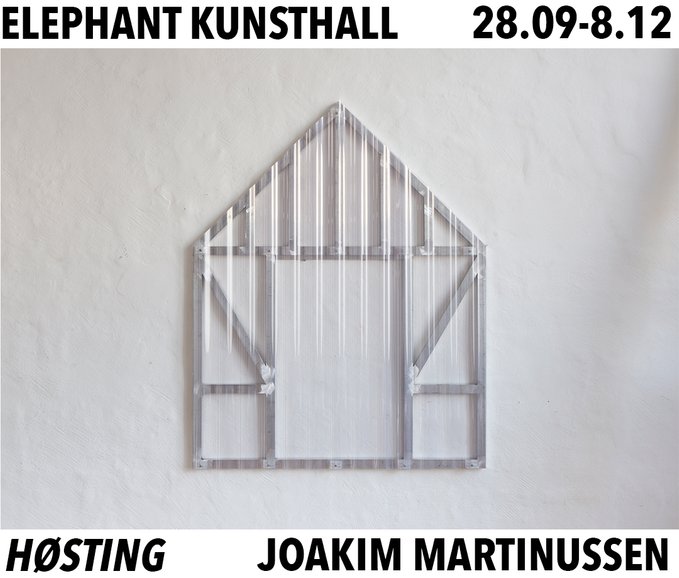HØSTING
Joakim Martinussen
28.09 - 08.12.19
Åpning: 28.09.19 kl 15:00
---
ELEPHANT KUNSTHALL har gleden av å presentere nye verk av Joakim Martinussen.
HØSTING er Martinussens første separatutstilling i Norge.
Several Notes on Lifecraft by Samuel Forsythe
I.
Strategy is about identifying or creating advantageous asymmetries at particular times and places,
mobilising the cusps of change and points of leverage that appear amidst chance and uncertainty.
II.
All humans are ecological engineers. We do not simply live in the world, passively reacting to
events, but actively engage, continually restructuring the environment to suit our needs and
constraints. Escaping from entropy and contingency we develop habits, techniques and instruments,
sets of decisions to approach the world a certain way, to transform it according to the patterns that
give each person, group and society their particular character, their form-of-life. We do this to
control and limit uncertainty but also to improve our chances, to increase the availability of
freedom, possibility and opportunity. Human customs are habits of design, and each identity is also
a strategy, a particular way of carving out niches of advantage from the chaos and adversity of the
planetary lifeworld. In the past there were savannah strategies, mountain strategies, jungle
strategies, desert strategies. Knowledge of entire ecologies and human histories were folded into the
skills, tools and systems that made us who we happened to be. Traps and tools, tents and shelters,
bags and recipes, artefacts and rituals, and most importantly, the techniques for encoding memory
into the landscape. The stability of the environment ensured the stability of the strategies.
III.
Communicative strategies are the modes of approach for navigating and constructing the group and
community, the cultivation of chances latent in the symbolic and social layers of the human
lifeworld. The consolidation of the human habitat as the urban structure produced new flows of
advantageous information, public speech and private secrets whose successful manipulation
depended on the savvy of the speaker and those who know how to listen unobserved. Advantage in
the human domain depends on the skilful manipulation of signs and symbols, the strategies of
concealment and disclosure, detection and deception, promises or lies. The skills of survival, freed
by the intentional construction of a stable environment, are adapted to the transient and
unpredictable circumstances of human interests and conflicts. The ingenuity of niche design applied
to the human world gives rise to the strategies of artifice and invention, of enciphering and
decoding, the skills of storytellers, artisans, troubadours and orators. The instability of the
environment demands the adaptability of the strategies.
IV.
The construction of technological niches in which we are dependent upon complex systems beyond
individual understanding and control produces a situation in which knowledge is elevated to the
primary instrument of power. Here, all free energy is put towards the efforts of prediction, control,
and preemptive action. The niche is reconstructed according to immense, invisible interests, and the
horizon of the future is subject to the designs of those situated at the centres of power. In this
environment strategic asymmetries can rapidly accumulate, allowing permanent regimes of decision
to become established, grow old, and solidify. Such grand schemes necessarily produce destabilising
counterstrategies, and encourage the growth of hidden niches. Here we find the secret lifeworlds of
language, symbols and narratives, private spaces for the cultivation of new growth and hybridity.
V.
Today many of us live inside of what has been described as an “accidental megastructure”, a vast
system of mediating technologies and the discontinuous strata of power and authority. This world is
every layer all at once, impossible to map or navigate in its totality. In this pseudo-virtual and nonlinear
environment the individual is challenged by ever-changing forms and shifting relations, and
reflects this external variability through constant internal adaptive compensations. In this complex
ecology hybrids abound, as do chimeras. Today each of us must master a variety of life strategies,
business strategies, identity strategies, and these decision systems must themselves change almost
every day, lest we fall victim to the illusions of certainty. What each of us fears is to miss the
moment when the current shifts, the scene changes, and we are left chasing the ghost of what we
wanted in a world where it is no longer possible. The rules change as the environment changes,
strategies once successful fail to gain traction in the new world of next week, and opportunity lies
half-hidden in the emerging patterns of an uncertain future.
VI.
Recently it has become possible to identify several emerging strategies for navigating the new
lifeworld:
_
Utstillingen er støttet av Norsk Kulturråd, Billedkunstnernes Vederlagsfond og Oppland Fylkeskommun
The strategy of non-attachment, the relinquishment of anything that does not produce both balance and mobility. The cultivation of a hidden centre.
The strategy of expertise in many different forms of movement. The ability to pivot quickly from one stance to the next, and to redistribute energy to where it is needed most in that moment.
The strategy of paying attention to how details are related to patterns, and the inscription upon memory of those details, relations and patterns.
The strategy of control over the production of signs and signatures. The mastery of mimicry, masquerade, camouflage and simulation.
The strategy of becoming entangled in a network of relationships. The ability to decode circumstances according to a variety of schema.
The strategy of belonging to a time and a place. The ability to totally be in one time and one place, at least for a short while.
